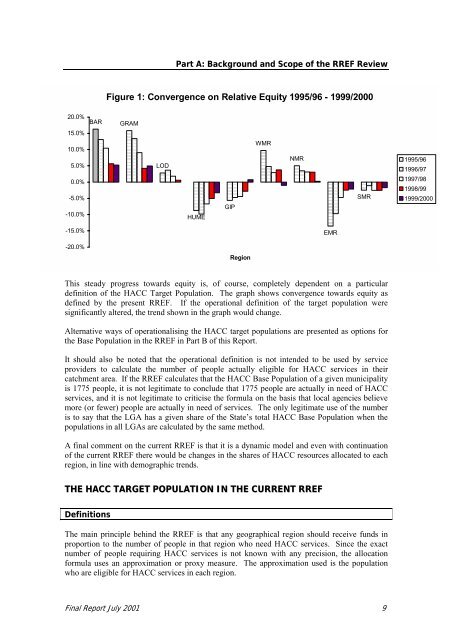Final Report on RREF 2001 - Department of Health
Final Report on RREF 2001 - Department of Health
Final Report on RREF 2001 - Department of Health
Create successful ePaper yourself
Turn your PDF publications into a flip-book with our unique Google optimized e-Paper software.
Part A: Background and Scope <strong>of</strong> the <strong>RREF</strong> Review<br />
Figure 1: C<strong>on</strong>vergence <strong>on</strong> Relative Equity 1995/96 - 1999/2000<br />
20.0%<br />
15.0%<br />
BAR<br />
GRAM<br />
10.0%<br />
5.0%<br />
0.0%<br />
-5.0%<br />
-10.0%<br />
LOD<br />
HUME<br />
GIP<br />
WMR<br />
NMR<br />
SMR<br />
1995/96<br />
1996/97<br />
1997/98<br />
1998/99<br />
1999/2000<br />
-15.0%<br />
EMR<br />
-20.0%<br />
Regi<strong>on</strong><br />
This steady progress towards equity is, <strong>of</strong> course, completely dependent <strong>on</strong> a particular<br />
definiti<strong>on</strong> <strong>of</strong> the HACC Target Populati<strong>on</strong>. The graph shows c<strong>on</strong>vergence towards equity as<br />
defined by the present <strong>RREF</strong>. If the operati<strong>on</strong>al definiti<strong>on</strong> <strong>of</strong> the target populati<strong>on</strong> were<br />
significantly altered, the trend shown in the graph would change.<br />
Alternative ways <strong>of</strong> operati<strong>on</strong>alising the HACC target populati<strong>on</strong>s are presented as opti<strong>on</strong>s for<br />
the Base Populati<strong>on</strong> in the <strong>RREF</strong> in Part B <strong>of</strong> this <str<strong>on</strong>g>Report</str<strong>on</strong>g>.<br />
It should also be noted that the operati<strong>on</strong>al definiti<strong>on</strong> is not intended to be used by service<br />
providers to calculate the number <strong>of</strong> people actually eligible for HACC services in their<br />
catchment area. If the <strong>RREF</strong> calculates that the HACC Base Populati<strong>on</strong> <strong>of</strong> a given municipality<br />
is 1775 people, it is not legitimate to c<strong>on</strong>clude that 1775 people are actually in need <strong>of</strong> HACC<br />
services, and it is not legitimate to criticise the formula <strong>on</strong> the basis that local agencies believe<br />
more (or fewer) people are actually in need <strong>of</strong> services. The <strong>on</strong>ly legitimate use <strong>of</strong> the number<br />
is to say that the LGA has a given share <strong>of</strong> the State’s total HACC Base Populati<strong>on</strong> when the<br />
populati<strong>on</strong>s in all LGAs are calculated by the same method.<br />
A final comment <strong>on</strong> the current <strong>RREF</strong> is that it is a dynamic model and even with c<strong>on</strong>tinuati<strong>on</strong><br />
<strong>of</strong> the current <strong>RREF</strong> there would be changes in the shares <strong>of</strong> HACC resources allocated to each<br />
regi<strong>on</strong>, in line with demographic trends.<br />
THE HACC TARGET POPULATION IN THE CURRENT <strong>RREF</strong><br />
Definiti<strong>on</strong>s<br />
The main principle behind the <strong>RREF</strong> is that any geographical regi<strong>on</strong> should receive funds in<br />
proporti<strong>on</strong> to the number <strong>of</strong> people in that regi<strong>on</strong> who need HACC services. Since the exact<br />
number <strong>of</strong> people requiring HACC services is not known with any precisi<strong>on</strong>, the allocati<strong>on</strong><br />
formula uses an approximati<strong>on</strong> or proxy measure. The approximati<strong>on</strong> used is the populati<strong>on</strong><br />
who are eligible for HACC services in each regi<strong>on</strong>.<br />
<str<strong>on</strong>g>Final</str<strong>on</strong>g> <str<strong>on</strong>g>Report</str<strong>on</strong>g> July <strong>2001</strong> 9
















